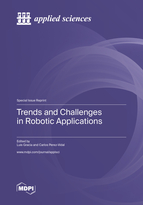Trends and Challenges in Robotic Applications
A special issue of Applied Sciences (ISSN 2076-3417). This special issue belongs to the section "Robotics and Automation".
Deadline for manuscript submissions: closed (20 August 2022) | Viewed by 111800
Special Issue Editors
Interests: robotic systems; system modeling and control; robust control
Special Issues, Collections and Topics in MDPI journals
Special Issue Information
Dear Colleagues,
Research done on robotic applications has significantly grown in the last decade, and currently, robotic systems are being utilized for many purposes. To achieve this generalized use of robots, researchers have been prolific in a wide variety of methods and algorithms to properly use robotic systems in many real-life scenarios.
At present, many types of robotic platforms are being used in different applications, e.g., dual arm robots, parallel robots, mobile robots, humanoid robots, aerial robots, underwater robots, and micro/nano robots. Moreover, some theoretical tools are specially being used to obtain a proper robot performance, e.g., machine learning, artificial intelligence, multi-agent systems, and control and planning theory.
The purpose of this Special Issue is to show the current state of robotic applications. In particular, in addition to introducing new theories and methods, this Special Issue is particularly focused on the use of robotic systems in real-life situations. Thus, the presentation of experimental results makes evident the feasibility and usefulness of robotic systems in practical cases.
Obviously, this Special Issue does not intend to exhaustively show all the current existing robotic applications but rather give an overview of them, showing the high level of activity in this area.
Potential topics include but are not limited to the following: human–robot collaboration and interaction; robot manipulation and manufacturing; robot control and planning; SLAM and robot navigation; robot learning and artificial intelligence; social and service robotics; bio-inspired robotics and soft robotics; multi-robot systems; rescue robotics and swarm robotics; micro and nano robotics; etc.
Prof. Dr. Luis Gracia
Dr. Carlos Perez-Vidal
Guest Editors
Manuscript Submission Information
Manuscripts should be submitted online at www.mdpi.com by registering and logging in to this website. Once you are registered, click here to go to the submission form. Manuscripts can be submitted until the deadline. All submissions that pass pre-check are peer-reviewed. Accepted papers will be published continuously in the journal (as soon as accepted) and will be listed together on the special issue website. Research articles, review articles as well as short communications are invited. For planned papers, a title and short abstract (about 100 words) can be sent to the Editorial Office for announcement on this website.
Submitted manuscripts should not have been published previously, nor be under consideration for publication elsewhere (except conference proceedings papers). All manuscripts are thoroughly refereed through a single-blind peer-review process. A guide for authors and other relevant information for submission of manuscripts is available on the Instructions for Authors page. Applied Sciences is an international peer-reviewed open access semimonthly journal published by MDPI.
Please visit the Instructions for Authors page before submitting a manuscript. The Article Processing Charge (APC) for publication in this open access journal is 2400 CHF (Swiss Francs). Submitted papers should be well formatted and use good English. Authors may use MDPI's English editing service prior to publication or during author revisions.







